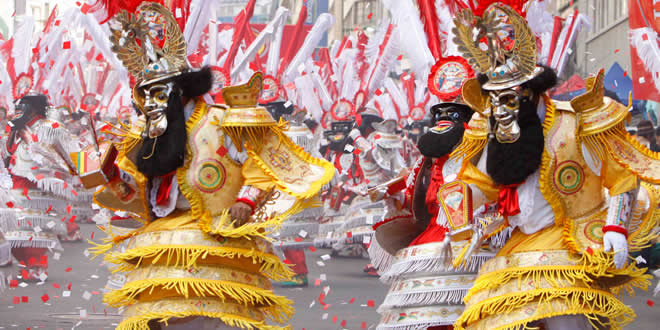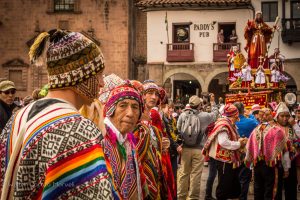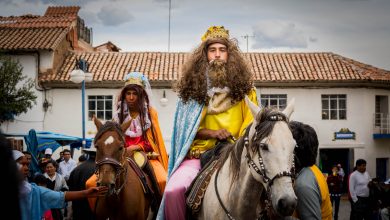Cuzco’s Corpus Christi and La Paz’s Gran Poder, Different Combinations of Faith, Culture, and Country

Cuzco celebrated Corpus Christi this week while last Saturday the people of La Paz Bolivia carried out a different, massive event. It was the Feast of the Lord of Great Power, in Spanish the Fiesta del Señor del Gran Poder. Like the great pilgrimage to Qoyllur Rit’i in Cuzco, Gran poder is linked to the calendar for Corpus Christi, the Catholic feast of the Body of Christ, the Holy Sacrament. Unlike in Cuzco, Gran Poder far exceeds Corpus Christi in La Paz and is the most important public event.
Though tied to an image of the Lord of Gran Poder held in a small church in the historic neighborhood of Chijini, and linked to notions of faith, still the event—consisting of more than 35,000 dancers representing 65 fraternities dancing for miles through the City of La Paz—was called a cultural festivity in the daily La Razón from which I also pulled the statistics.
This use fascinates me because it removes the emphasis from religion and the Church to place it on culture, and from a fiesta (feast) to a festivity. This shift is significant here, in that it involves a change of emphasis which while not completely removing the Catholic Church reduces its importance and instead grants centrality to the idea of culture.
Many people use the word culture as something that all people just have yet here the word includes that and connects it with public display, an abstract culture reflected back to society and to the people. It is a kind of presentation.
It is tempting to discuss what each of the dance troupes — the morenada, caporales, tinku, kullawada, etc. — means. In that idea though we run into a problem. You can turn to many books and find descriptions of what the dances signify, at least according to the idea that as meaningful things they refer to something else and that other thing is what they mean. Thus you do not have to look far to find people saying that the morenadas “parody” the African slaves who were brought to work in the wineries of Bolivia. The idea that they stand for Black people, slaves, is common.

The more important meaning here, though, is not one of this kind of meaning where something stand for something else (to paraphrase C.S. Pierce). Instead, it is that of a kind of presentation where it shows in its presence a connection to something else, what Peirce called indexicality. It calls into being something with which it shares a tie in space or time.
In this case it is that the morenada has been performed by urban people of indigenous origin for a very long time, as well as in many Aymara-speaking communities. There is a complex history here, but for right now it is not the history but the way the morenada immediately reminds people of its connection with these kinds of Bolivians, indigenous ones, whether urban or rural.
As a result, it also presents statements from Bolivia’s constitution of 2009. That document that governs the country sets up these indigenous people as foundational to Bolivia and key to its current reality.

In Cusco’ Corpus Christi we see some of this although it is also different. The Church and the saints simply are critical in the entradas, as they are called in Bolivia, or pasacalles– processions in Cuzco. Dance troupes line up with different saints and accompany them through the plaza and the city.
However, the event is also supported and codified by the Ministry of Culture. Where you can see this is in the altars of bright colors and glass set up around the plaza. On the top of one of altars, in one of the holiest spaces, you will see the name Ministerio de Cultura, the Ministry of Culture. As a result, the Church (religion) enters into tension and cooperation with the idea of culture.
While in La Paz, the key idea today is the indexical rendering of indigenous people and their culture as key to the nation, in Cuzco, Corpus Christi still maintains the idea of Cuzco’s people connected to the Church, to the Holy Host, and then to the nation as culture bearing beings. The indigenous nature of the peoples is less the idea than their ancestral commitment, as Incas, to Catholicism and to Christ.




